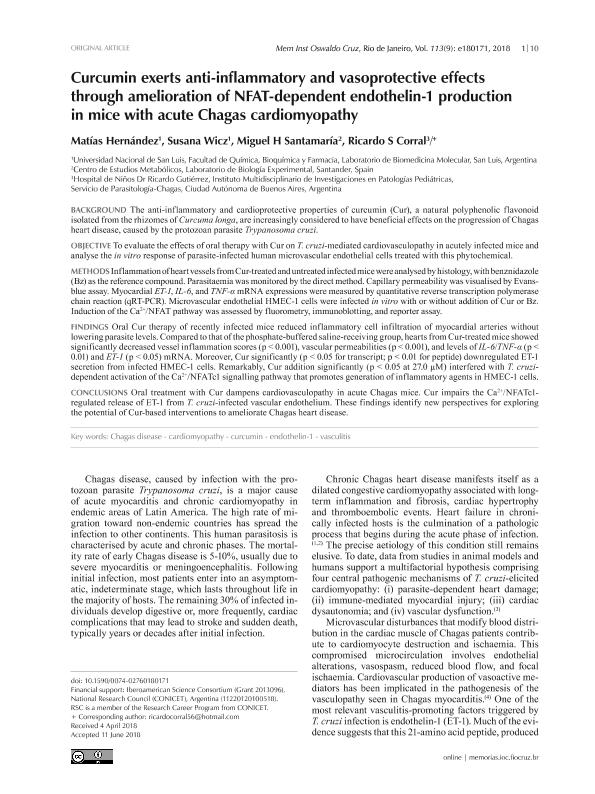Artículo
Curcumin exerts anti-inflammatory and vasoprotective effects through amelioration of NFAT-dependent endothelin-1 production in mice with acute Chagas cardiomyopathy
Fecha de publicación:
07/2018
Editorial:
Fundação Oswaldo Cruz
Revista:
Memorias do Instituto Oswaldo Cruz
ISSN:
1678-8060
Idioma:
Inglés
Tipo de recurso:
Artículo publicado
Clasificación temática:
Resumen
BACKGROUND The anti-inflammatory and cardioprotective properties of curcumin (Cur), a natural polyphenolic flavonoid isolated from the rhizomes of Curcuma longa, are increasingly considered to have beneficial effects on the progression of Chagas heart disease, caused by the protozoan parasite Trypanosoma cruzi. OBJECTIVE To evaluate the effects of oral therapy with Cur on T. cruzi-mediated cardiovasculopathy in acutely infected mice and analyse the in vitro response of parasite-infected human microvascular endothelial cells treated with this phytochemical. METHODS Inflammation of heart vessels from Cur-treated and untreated infected mice were analysed by histology, with benznidazole (Bz) as the reference compound. Parasitaemia was monitored by the direct method. Capillary permeability was visualised by Evansblue assay. Myocardial ET-1, IL-6, and TNF-α mRNA expressions were measured by quantitative reverse transcription polymerase chain reaction (qRT-PCR). Microvascular endothelial HMEC-1 cells were infected in vitro with or without addition of Cur or Bz. Induction of the Ca2+/NFAT pathway was assessed by fluorometry, immunoblotting, and reporter assay. FINDINGS Oral Cur therapy of recently infected mice reduced inflammatory cell infiltration of myocardial arteries without lowering parasite levels. Compared to that of the phosphate-buffered saline-receiving group, hearts from Cur-treated mice showed significantly decreased vessel inflammation scores (p < 0.001), vascular permeabilities (p < 0.001), and levels of IL-6/TNF-α (p < 0.01) and ET-1 (p < 0.05) mRNA. Moreover, Cur significantly (p < 0.05 for transcript; p < 0.01 for peptide) downregulated ET-1 secretion from infected HMEC-1 cells. Remarkably, Cur addition significantly (p < 0.05 at 27.0 μM) interfered with T. cruzidependent activation of the Ca2+/NFATc1 signalling pathway that promotes generation of inflammatory agents in HMEC-1 cells. CONCLUSIONS Oral treatment with Cur dampens cardiovasculopathy in acute Chagas mice. Cur impairs the Ca2+/NFATc1- regulated release of ET-1 from T. cruzi-infected vascular endothelium. These findings identify new perspectives for exploring the potential of Cur-based interventions to ameliorate Chagas heart disease.
Archivos asociados
Licencia
Identificadores
Colecciones
Articulos(IMIPP)
Articulos de INSTITUTO MULTIDISCIPLINARIO DE INVESTIGACIONES EN PATOLOGIAS PEDIATRICAS
Articulos de INSTITUTO MULTIDISCIPLINARIO DE INVESTIGACIONES EN PATOLOGIAS PEDIATRICAS
Citación
Hernández, Matías; Wicz, Susana; Santamaría, Miguel H.; Corral, Ricardo Santiago; Curcumin exerts anti-inflammatory and vasoprotective effects through amelioration of NFAT-dependent endothelin-1 production in mice with acute Chagas cardiomyopathy; Fundação Oswaldo Cruz; Memorias do Instituto Oswaldo Cruz; 113; 9; 7-2018; 1-10
Compartir
Altmétricas




